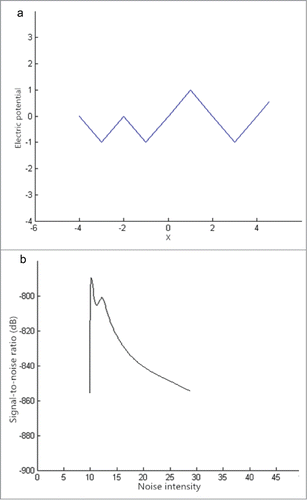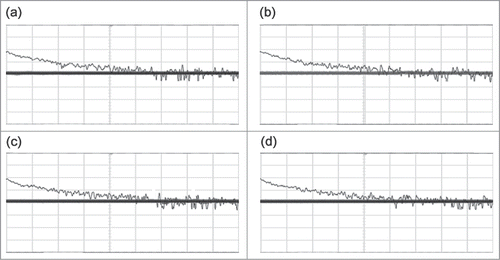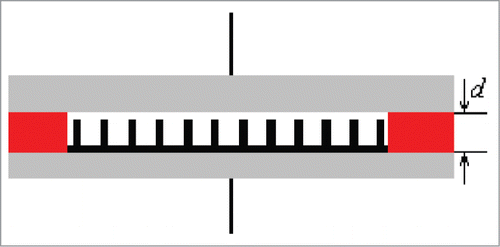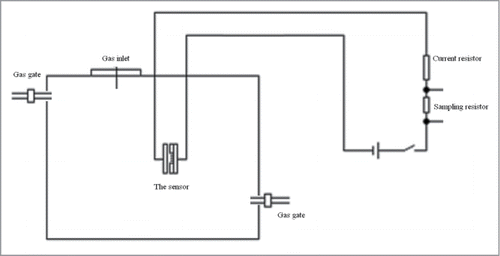 ?Mathematical formulae have been encoded as MathML and are displayed in this HTML version using MathJax in order to improve their display. Uncheck the box to turn MathJax off. This feature requires Javascript. Click on a formula to zoom.
?Mathematical formulae have been encoded as MathML and are displayed in this HTML version using MathJax in order to improve their display. Uncheck the box to turn MathJax off. This feature requires Javascript. Click on a formula to zoom.Abstract
The detecting mechanism of carbon nanotubes gas sensor based on multi-stable stochastic resonance (MSR) model was studied in this paper. A numerically stimulating model based on MSR was established. And gas-ionizing experiment by adding electronic white noise to induce 1.65 MHz periodic component in the carbon nanotubes gas sensor was performed. It was found that the signal-to-noise ratio (SNR) spectrum displayed 2 maximal values, which accorded to the change of the broken-line potential function. The experimental results of gas-ionizing experiment demonstrated that periodic component of 1.65 MHz had multiple MSR phenomena, which was in accordance with the numerical stimulation results. In this way, the numerical stimulation method provides an innovative method for the detecting mechanism research of carbon nanotubes gas sensor.
Introduction
In signal measurement occasions, it is difficult to extract eigen values of weak signals from a complex background noise system.Citation1-3 MSR, a novel non-linear dynamic model, was proposed by Benzi for the explanation for Earth climate periodic changes in 1980s.Citation4-5 In a non-linear dynamic system, weak signals can be significantly amplified by adding external noise to a MSR system.Citation6-8 MSR has been a useful data processing technique and is widely applied in many research fields such as physics,Citation9-11 medicals,Citation12,13 biochemistry,Citation14,15 chemical physics,Citation16,17 etc.
Lin et al first reported the phenomenon of the output SNR in a magnetized plasma system.Citation18 And this method was widely applied to solve some fuzzy problems, such as fault diagnosis,Citation6,7,19 weak signal detection,Citation7,20 etc. Hui, Wang, Mo and Zhang (2012) built a rapid quality predictive model about grass carp using electronic nose combined with MSR SNR analysis.Citation21 Liu, Han, Cai, Jin and Hui (2015) proposed a rapid determination method for Penaeus orientolis prawn freshness based on electronic nose and non-linear MSR technique, and built the relationship between the physical/chemical indexes and double-layered cascaded serial stochastic resonance (DCSSR) by multi-variables regressions (MVR).Citation22 Jin, Zheng, Ge, Deng, Liu and Hui (2015) realized qualitative discrimination for glucose, D-fructose, and sucrose using non-linear SNR spectrum.Citation23 Jin, Ge, Zheng, Cai, Liu and Hui (2015) provided a novel discriminating method for sweetener species by non-linear SNR technique.Citation24 However, little information about the study of detecting mechanism of carbon nanotubes gas sensor based on MSR model was reported.
In this study, the detecting mechanism of carbon nanotubes gas sensor was studied using non-linear MSR model. Numerical stimulation based on MSR was carried out. Meanwhile, gas-ionizing experiment by adding Gaussian white noise with different intensities to the carbon nanotubes gas sensor was performed.
Results and discussion
Numerical stimulation result
The developed numerical stimulation model is displayed in . Electrical potential periodically changes with the change of x. Potential wells appear at the position of x about −3, −1 and 3, respectively. And this model provides theoretical support for following SNR spectrum analysis.
Figure 1. Numerical stimulation results: (A) Broken-line potential function; (B) SNR spectrum analysis.

SNR spectrum analysis results calculated by MSR as a function of noise intensity are displayed in . SNR values range from −786 dB to −781 dB, and change with the increase of noise intensity. SNR value begins with −878 dB at the noise intensity of near 2. Two maximal peak values appear at the noise intensity of 2.5 and 6, respectively. After that, SNR value decreases with increase of noise intensity. When modulated by white noise, the first MSR phenomena occurs between the potential well 1 and the potential well 2, leading to the formation of the first SNR eigen peak. With the increase of noise intensity, the transition probability of Brownian particle from the potential well 2 to the potential well 3 rises. However, the SNR value rapidly declines due to the status change of the first MSR. With the increase of noise intensity, particle requires adequate energy to move between the 3 potential wells, which lead to the results of SNR spectrum increase. When the noise intensity rises to some extent, the movement period of Brownian particle equals to the driving cycle, and thereby the second SNR eigen peak emerges. SNR spectrum analysis agreed with the numerical stimulation model well. The numerical stimulation results gave a reasonable explanation for the MSR phenomena of gas ionization sensor.
Experimental detection result
The Fourier transform (FT) frequency spectrum recorded by the oscilloscope under different noise intensities is displayed in . When the noise intensity is close to zero, the current in the system change a little. And it a periodic component near 1.63 MHz in the frequency spectrum and a small SNR value (see ) can be observed. When the noise intensity reaches 9.2V, the periodic component significantly increases and the SNR value improves. And fragmentary discharge pulses appear due to the improved current (see ). When the noise intensity reaches 12V, the component significantly declines and the SNR value decreases (see ). When the noise intensity reaches 15.4V, a totally different phenomenon occurs (see ). The eigen component improves and the SNR spectrum increases.
Figure 2. Frequency spectrum in different noise intensity of (A) zero; (B) 8.5V; (C) 11.7V; (D) 14.3V.

The formatting mechanism of 1.63 MHz periodic component is not clear yet. But we could give a possible explanation based on the analysis of gas ionizing characteristics. Gas ionizing is one of the most important research areas in non-linear dynamic research, and DC discharge plasma plays an important role. According to the gas ionizing theory, the self-sustaining dark discharge area is close to the front glow discharge area. The experiment system is in the self-sustaining dark discharge area, so some fragmentary discharge pulses can be observed. By adding external noise, the system enters into the front glow discharge area and electrode pads are in a stable condition, which is similar to non-linear DC discharge plasma. Compared to ions, the electron in the plasma keeps a stable non-thermal status. The ions with positive charges and the electrons with negative charges in the plasma are of high density and in a continuous motion status. The positive and negative charges produced by gas ionizing generate, and their escaping rates are equal. This phenomenon makes the plasma to be electric neutrality. Plasma vibration is a collective motion formed by the interactions of the particles. The plasma frequencies of electrons and ions represent their highest frequency inducing collective motion, which can be calculated as following:(1)
(1)
(2)
(2)
Where, is the plasma density,
is the dielectric constant in the vacuum environment,
is the electric mass,
is the ion mass. The particle concentration in glow discharge area is about 10Citation16 m−3. So we compare the ion oscillation frequency under the same condition. The ion oscillation frequency of argon, nitrogen, neon and helium are calculated and obtained as near 3.2 MHz, 1.91 MHz, 2.3 MHz, and 1.1 MHz, respectively. In gas ionizing experiment, we conclude that the oscillation is due to the complex components in carbon nanotubes gas sensor, and subsequently forms 1.63 MHz periodic component.
In this research, numerical stimulation about MSR was performed. And gas-ionizing experiment was conducted to validate the stimulating results of numerical model. The results suggested that the experimental results accorded with the numerical stimulating results well.
Materials and methods
Devices and chemical regents
Agilent digital oscilloscope was purchased from American Agilent Company. Polipower alternating current power supply was purchased from Denmark. QJ6005 cocurrent stable supply was purchased from Hongcheng Electronic Technology Co. Ltd., (Suzhou, China). Automatic digital multimeter was purchased from Shenzhen Victory Advanced Electronic Technology Co. Ltd., (Shenzhen, China). High pure (99.999%) aluminum plate was purchased from Shanghai Special material Co. Ltd., (Shanghai, China). Continuously adjusted high pressure cocurrent supply (0-800V) and carbon nantube growth furnace were self-made in our lab. Cobaltous sulfate (analytically pure) was purchased from Zhejiang Yixing Chemical Reagent Co. Ltd., (Yixing, Zhejiang). Deionized water was used in the experiment.
Preparation of carbon nanotubes gas sensor
High pure (99.999%) aluminum plate was ultrasonic cleaned in the mixture solution of acetone and ethanol (1:1) for 30 min. After that, it was polished in the mixture solution of ethanol and perchloric acid for 10 min and using deinoized water to wash. Then put it to 0.3 mol/L oxalic acid solution and use current supply (40 V) to oxidize it in the positive pole for an hour. Later, place it to the 5% phosphoric acid and chamber it under 50°C° for 15 min. The size, gap and depth of the pore was 60 nm, 100 nm and 2 μm, respectively. Thus the anodic aluminum oxide (AAO) formwork was completed. Then, using alternating current power supply to deposit cobalt particles (the size was near 60 nm) under the AAO formwork in the mixture solution of 60 g/L cobaltous sulfate and 25 g/L boric acid. After that, the AAO formwork was placed into the carbon nanotubes growth furnace. When it reached to 645°C, an airflow of acetylene and hydrogen (1:2, V/V) was introduced for 5–10 min. After cooling to the room temperature, it was taken with the protection of nitrogen.
The carbon nanotubes gas sensor consists of 2 poles. Carbon nanotubes electrode was used as the positive pole (see ), and aluminum plate was used as the negative pole. The carbon nanotubes electrode was packaged with insulating membrane material. And the membrane packaging gas detection part was cut to expose the carbon nanotubes. And then the aluminum plate was used to package the membrane. So, the detection part of carbon nanotubes corresponds to the negative pole, which effectively controls the gap between the 2 poles.
Detection system
The schematic structure of gas ionizing experimental system is displayed in . It consists of 2 main parts: carbon nanotubes gas ionizing device and electronic signal acquiring device. Carbon nanotubes gas sensor was put in an airtight detecting air chamber, where R = 100 K, R1 = 1 K. Change in the voltage of the electrode induces the change of electronic signal in the oscilloscope, which realizes the parameter measurements due to gas ionizing phenomena.
MSR
MSR is a typical non-linear model and proposed by Benzi for the explanation for Earth climate periodic changes.Citation1,25,26 MSR phenomenon has 3 elements: a bistable system, a coherent input, and a noise source,Citation1 which can be described as(3)
(3)
Where is the position of the Brownian particle,
is the time,
is periodical signal intensity,
is signal frequency.
is external noise intensity. M and D are adjustable parameters,
denotes carbon nanotubes sensor signal
and intrinsic noise
,
is the external noise, and
is the simplest double-well potential with the constants
and
characterizing the system. Noise intensity is a parameter of MSR model. MSR model is used as a data processing method in this research.
(4)
(4)
EquationEq. (3)(3)
(3) can be written as
(5)
(5)
The minima of are located at
, where
. A potential barrier separates the minima with the height given by
. The barrier top is located at
. When three elements of MSR interact coherently, the potential barrier can be reduced and the Brownian particle may surmount the energy barrier and enter another potential well.Citation1 The intensity of signals will increase, which makes it possible that the weak signal can be detected from noise background. SNR is the common quantifier for MSR and it can be approximately described asCitation1
(6)
(6)
Numerical stimulation
According to the MSR combined with multi-stable characteristics in the dynamic system, EquationEq. (7)(7)
(7) is used to performed numerical stimulation.
(7)
(7)
Where, is the Gaussian white noise,
is the potential function,
is the position of the Brownian particle,
is the time,
is periodical signal intensity.
Conclusions
In this paper, the detecting mechanism of carbon nanotubes gas sensor utilizing non-linear MSR model was studied. Numerical stimulation based on MSR was performed, and SNR value was calculated. Gas-ionizing experiment by adding external white noise induced 1.63 MHz periodic component in spectrum area. The numerical stimulation results demonstrated that 2 maximal SNR values appeared in the SNR spectrum, which explained the change of the potential fluctuation. In addition, the results of gas-ionizing experiment indicated that 1.63 MHz periodic component in the frequency spectrum had MSR phenomena under different noise intensity, which accorded with the numerical stimulation results well. Therefore, the numerical stimulation method successfully explained the detection mechanism of carbon nanotubes gas sensor. And this method provides a novel way for carbon nanotubes sensor detecting mechanism research.
Disclosure of Potential Conflicts of Interest
No potential conflicts of interest were disclosed.
Funding
This work is financially supported by Zhejiang Province Natural Science Foundation (Grant No. Y107003).
References
- Benzi R, Sutera A, Vulpiana A. The mechanism of stochastic resonance. J Phys A 1981; 14:L453–56; http://dx.doi.org/10.1088/0305-4470/14/11/006
- Andreasen M M, Christensen BJ. The SR approach: A new estimation procedure for non-linear and non-Gaussian dynamic term structure models. J Econom 2015; 184:420–451; http://dx.doi.org/10.1016/j.jeconom.2014.10.002
- Yang TT, Zhang HQ, Xu Y, Xu W. Stochastic resonance in coupled underdamped bistable systems driven by symmetric trichotomous noises. Int J Non-Linear Mechan 2014; 67:42–47; http://dx.doi.org/10.1016/j.ijnonlinmec.2014.07.008
- Han QL, Yang T, Zeng CH, Wang H, Liu ZQ, Fu YC, Zhang C, Tian D. Impact of time delays on stochastic resonance in an ecological system describing vegetation. Physica A Statist Mechan Appl 2014; 408:96–105; http://dx.doi.org/10.1016/j.physa.2014.04.015
- Hui GH, Mi SS, Ye SY, Jin JJ, Chen QQ, Yu Z. Tastant quantitative analysis from complex mixtures using taste cell-based sensor and double-layered cascaded series stochastic resonance. Electrochimica Acta 2014; 136:75–88; http://dx.doi.org/10.1016/j.electacta.2014.05.060
- Wang J, He QB, Kong FR. An improved multiscale noise tuning of stochastic resonance for identifying multiple transient faults in rolling element bearings. J Sound Vibration 2014; 333:7401–7421; http://dx.doi.org/10.1016/j.jsv.2014.08.041
- Qin Y, Tao Y, He Y, Tang BP. Adaptive bistable stochastic resonance and its application in mechanical fault feature extraction. J Sound Vibration 2014; 333:7386–7400; http://dx.doi.org/10.1016/j.jsv.2014.08.039
- Ma YM, Duan FB. Comparison of stochastic resonance in static and dynamic nonlinearities. Phys Lett A 2014; 378:2651–2656; http://dx.doi.org/10.1016/j.physleta.2014.07.025
- Ichiki A, Tadokoro Y. Signal-to-noise ratio improvement by stochastic resonance in moments in non-dynamic systems with multiple states. Phys Lett A 2013; 377:185–188; http://dx.doi.org/10.1016/j.physleta.2012.11.038
- Guo F, Li H, Liu J. Stochastic resonance in a linear system with random damping parameter driven by trichotomous noise. Phy A Statist Mechan Appl 2014; 409:1–7; http://dx.doi.org/10.1016/j.physa.2014.04.034
- Koverda VP, Skokov VN. Stochastic resonance and 1/f noise at coupled phase transitions. Phys Statist Mechan Appl 2014; 393:173–181; http://dx.doi.org/10.1016/j.physa.2013.09.050
- Guo W, Mei D-C. Stochastic resonance in a tumor-immune system subject to bounded noises and time delay. Phys A Statist Mechan Appl 2014; 416:90–98; http://dx.doi.org/10.1016/j.physa.2014.08.003
- Duan W-L, Long F, Li C. Reserve resonance and stochastic resonance in intracellular calcium oscillations. Phys Statist Mechan Appl 2014; 401:52–57; http://dx.doi.org/10.1016/j.physa.2014.01.025
- Karig DK, Siuti P, Dar RD, Retterer ST, Doktycz MJ, Simpson ML. Model for biological communication in a nanofabricated cell-mimic driven stochastic resonance. Nano Commun Networks 2011; 2:39–49; PMID:21731597; http://dx.doi.org/10.1016/j.nancom.2011.03.001
- Deng B, Wang L, Wang J, Wei X-L, Yu H-T. Endogenous fields enhanced stochastic resonance in a randomly coupled neuronal network. Chaos Solitons Fractals 2014; 68:30–39; http://dx.doi.org/10.1016/j.chaos.2014.07.006
- Heinsalu E, Patriarca M, Marchesoni F. Stochastic resonance in a surface dipole. Chem Phys 2010; 375:410–415; http://dx.doi.org/10.1016/j.chemphys.2010.03.013
- Ditlevsen PD. Extension of stochastic resonance in the dynamics of ice ages. Chem Phys 2010; 375:403–409; http://dx.doi.org/10.1016/j.chemphys.2010.05.022
- Lin I, Liu J. Experimental observation of stochastic resonance like behavior of autonomous motion in weakly ionized of magnetoplasmas. Phys Rev Lett 1995; 74:3161–3164; PMID:10058127; http://dx.doi.org/10.1103/PhysRevLett.74.3161
- Li JM, Chen XF, He ZJ. Multi-stable stochastic resonance and its application research on mechanical fault diagnosis. J Sound Vibration 2013; 332:5999–6015; http://dx.doi.org/10.1016/j.jsv.2013.06.017
- Lu SL, He QB, Kong FR. Effects of underdamped step-varying second-order stochastic resonance for weak signal detection. Digital Signal Process 2015; 36:93–103; http://dx.doi.org/10.1016/j.dsp.2014.09.014
- Hui GH, Wang LY, Mo YH, Zhang LX. Study of grass carp (Ctenopharyngodon idellus) quality predictive model based on electronic nose. Sensors Actuators B 2012; 166–167:301–308; http://dx.doi.org/10.1016/j.snb.2012.02.066
- Liu W, Han YY, Cai YP, Jin JJ, Hui GH. Penaeus orientolis prawn freshness rapid determination method based on electronic nose and non-linear stochastic resonance technique. Bioengineered 2015; 6:1–11; PMID:25531187; http://dx.doi.org/10.1080/21655979.2015.1038001
- Jin JJ, Zheng GY, Ge YY, Deng SG, Liu W, Hui GH. A non-enzyme electrochemical qualitative and quantitative analyzing method for glucose, D-fructose, and sucrose utilizing Cu foam material. Electrochim Acta 2015; 153:594–601; http://dx.doi.org/10.1016/j.electacta.2014.11.194
- Jin JJ, Ge YY, Zheng GY, Cai YP, Liu W, Hui GH. D-Glucose, D-Galactose, and D-Lactose non-enzyme quantitative and qualitative analysis method based on Cu foam electrode. Food Chem 2015; 175:485–493; PMID:25577110; http://dx.doi.org/10.1016/j.foodchem.2014.11.148
- Gammaitoni L, Hanggi P, Jung P, Marchesoni F. Stochastic resonance. Rev Modern Phys 1998; 70:223–287; http://dx.doi.org/10.1103/RevModPhys.70.223
- Dutta R, Das A, Stocks NG, Morgan D. Stochastic resonance-based electronic nose: A novel way to classify bacteria. Sensors and Actuators B 2006; 115:17–27; http://dx.doi.org/10.1016/j.snb.2005.08.033


